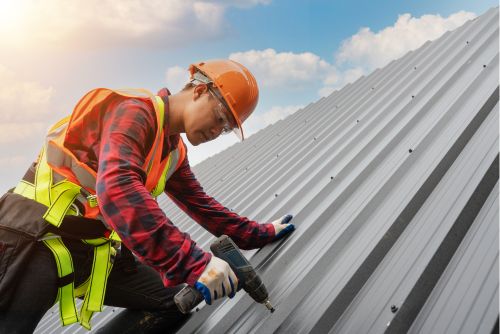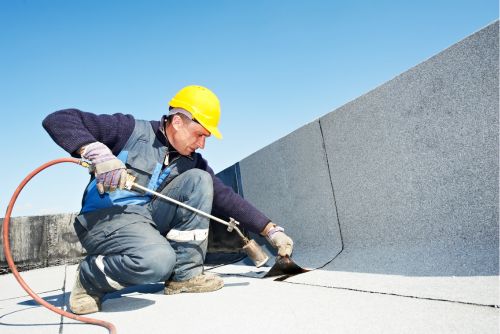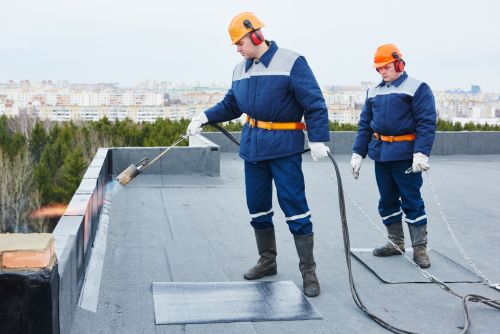
When it comes to the world of buildings, there is an often overlooked aspect that plays a crucial role in keeping everything together: commercial roofing. This unsung hero, if you will, is responsible for providing shelter and protection to businesses, warehouses, and other commercial properties.
But what exactly is commercial roofing, and how does it differ from its residential counterpart? Well, let’s just say that it’s more than just a covering for your building, and the answer might surprise you.
So, if you’re curious to uncover the secrets behind this essential component of any commercial property, join me as we explore the world of commercial roofing and all that it entails. Read more of this article to know what is a commercial roofing and its benefits for your property.
Commercial roofing involves installing and maintaining roofs on commercial buildings. Innovative methods and materials are used to prolong and improve commercial roofs. Commercial roofs can withstand heavy foot traffic, extreme weather, and mechanical systems found in commercial buildings.
Commercial roofing is more than covering a building. It includes planning, installing, and maintaining a commercial roof. Larger commercial roofs require specialized materials and methods for durability and energy efficiency.
Innovation is key in commercial roofing. Technologies and materials have transformed the industry, enabling more efficient installation and sustainable roofing. Commercial roofing evolves to meet modern building needs, from energy-efficient materials to advanced insulation systems.
Commercial roof design and aesthetics are also innovative. Architects and building owners are exploring unique roofing designs that protect and beautify the building. For instance, green roofs use vegetation to improve the environment and look better.

As a commercial roofer, I’ve noticed several key differences between residential and commercial roofing. Commercial roofing projects are larger and more complicated. Commercial roofs cover large areas like office buildings, warehouses, and malls. This requires specialized knowledge and expertise to handle the unique challenges of large-scale projects.
A major difference is commercial roofing materials. Commercial roofs use metal, EPDM, TPO, or PVC, while residential roofs use asphalt shingles or tiles. For their durability and weather resistance, these materials are used to protect commercial properties.
Installation is another difference. The new roof is simply installed over the old one in residential roof installations. Commercial roofs usually need to be completely removed before installation. This addresses any underlying issues and ensures a thorough installation.
Commercial roofs need more frequent and extensive repairs than residential roofs. This is due to increased foot traffic, larger HVAC systems, and rooftop equipment. Regular maintenance and repairs are essential for commercial roofs due to their constant use and weather exposure.
Any commercial property needs a sturdy roof to succeed and last. A commercial roof protects the building from the elements and improves energy efficiency and appearance. In today’s innovative world, a sturdy commercial roof and its benefits are crucial.
There are three main reasons to buy a sturdy commercial roof:

What materials are used in commercial roofing?
Commercial roofing requires innovation. Each type of commercial roofing material has its own benefits and features.
Reinforced roof fabric is popular in commercial roofing. Made from high-strength fibers and bitumen, these fabrics are weatherproof and durable. Reinforced roof fabrics can withstand high winds, rain, and extreme temperatures. They’re lightweight and easy to install, making them popular for commercial roofing projects.
Another popular commercial roofing material is bitumen. Bitumen is a black, sticky, viscous petroleum-based liquid. It creates a waterproof, durable roofing material when mixed with other materials. Bitumen roofs tend to last and withstand harsh weather. They’re affordable and fire-resistant.
Single-ply membrane is another popular commercial roofing material. The membranes are made of one layer of PVC or TPO. Single-ply membrane roofs are lightweight, flexible, and installable. They resist chemicals, UV rays, and pollutants well. They’re durable and low-maintenance.
Commercial roofs often have common issues that affect performance and longevity. To ensure your commercial roofing system’s effectiveness, you must understand and address these issues quickly as an innovative audience seeking solutions.
Some common commercial roof issues include:

To know more of what is a commercial roofing, let us discover its benefits. Commercial roof maintenance has many benefits that extend its lifespan and functionality. Commercial roofing requires regular maintenance to stay in good condition and protect your business. Regular maintenance prevents costly repairs and extends roof life.
Regular commercial roof maintenance helps identify and resolve issues before they become major ones. Regular inspections can detect and repair damage or wear early. This proactive approach can prevent minor issues from becoming costly repairs.
Keep your commercial roof energy-efficient with regular maintenance. Roof leaks or gaps let air escape, raising heating and cooling costs. To reduce energy waste and lower utility bills, regularly inspect and maintain your roof to keep it sealed and insulated.
Regular maintenance can also preserve your commercial roof’s appearance. Algae and environmental factors can stain roofs. You can improve your business’s appearance by regularly cleaning and maintaining your roof.
After learning about commercial roofing, let’s discuss the different types of roofs used in commercial buildings.
Building or renovating commercial properties requires knowledge of commercial roofing types. Choosing the right type can improve a commercial building’s efficiency, durability, and aesthetics.
Built-up roofing for protection, industrial roofing for heavy-duty applications, metal roofing for a modern look, and EPDM roofing for excellent insulation—the options are endless. Be creative and create a commercial roof that meets your needs.

I’m excited to discover innovative and efficient commercial roofing solutions. Commercial roofing systems now offer many options to meet the diverse needs of commercial buildings.
Installation is important when choosing a commercial roofing system. Modern technology allows faster and more efficient installation. Commercial buildings need this because time is of the essence. Businesses can minimize disruption and resume operations by choosing a fast-installing roofing system.
The durability of the roofing system is also important. Commercial buildings face harsh weather, so choosing a roofing option that can withstand heavy rain, strong winds, and extreme temperatures is crucial. Modern commercial roofing systems are constructed to last and protect the building and its occupants.
Additionally, material options must be explored. There are many materials to choose from, including asphalt, metal, EPDM, and TPO. Cost, durability, and energy efficiency should be considered when choosing a material because each has its own advantages.
After considering commercial roofing options, consider the pros and cons of shingles.
Shingles have been popular for residential roofing for years, but their use in commercial applications requires careful consideration. Shingles have pros and cons for commercial roofing:
While shingles offer several advantages in commercial roofing, there are also some drawbacks to consider:

Business owners and property managers prefer flat roofs for commercial properties due to their many benefits. Commercial flat roofs offer innovative, practical, and efficient solutions.
A major benefit of flat roofs is their affordability. Flat roofs cost less to install and maintain than pitched roofs because they require fewer materials and labor. For commercial properties with large roofs, this is ideal.
Flat roofs increase usable space and save money. Flat roofs are level and can be used for various purposes, unlike pitched roofs. Businesses can generate renewable energy with rooftop gardens, outdoor seating, or solar panels. This boosts commercial property functionality, sustainability, and innovation.
Another benefit of flat roofs is durability. Flat roofs can protect commercial properties for decades with proper installation and maintenance. EPDM and TPO flat roofing materials can withstand heavy rain, snow, and UV radiation. Businesses save time and money by reducing repairs and replacements due to this durability.
Flat roofs are easy to maintain and access. Since they have a low or no slope, technicians can easily inspect and repair the roof. Maintenance is faster and less disruptive to commercial property operations due to this accessibility.
A commercial roofer is essential to a building’s roofing system’s longevity. The ever-changing field of commercial roofing requires a skilled professional who can keep up with new techniques.
My job as a commercial roofer goes beyond installing and repairing roofs. Three key duties demonstrate my role’s importance:

Property owners prefer metal roofing for commercial buildings due to its many benefits.
Durability is crucial for commercial roof systems. Metal roofing lasts for years, protecting the building from the elements. Metal roofing is better than other roofing materials because it resists fire, wind, and hail.
The durability of metal roofing for commercial buildings is another benefit. With proper care, metal roofs can last 50 years or more. Roof repairs and commercial roof replacements are cheaper in the long run for property owners.
Energy efficiency and durability are combined in metal roofing. Metal roofs reflect a lot of solar heat, lowering summer cooling costs. It saves a lot on energy bills and is environmentally friendly.
Metal roofing also has many design and aesthetic options. It can be customized to fit any architectural style, giving commercial building owners the look they want. Metal roofs offer endless creative and innovative possibilities due to their many colors and finishes.
In conclusion, commercial roofing plays a crucial role in protecting commercial buildings from the elements and maintaining the structural integrity of the property. With a variety of materials and roofing types available, it’s important to choose the right option that suits the specific needs and requirements of the commercial property.
Consulting with a professional commercial roofer can help ensure a sturdy and long-lasting roof that will stand the test of time. So no you know more about what is a commercial roofing.
Commercial roofing costs depend on roof size, materials, and installation complexity. A professional assessment and quote are essential to determining your project’s cost. However, a high-quality commercial roofing system can improve energy efficiency and lower maintenance costs over time.
Residential roofers can work on commercial roofs. However, commercial roofing requires specific skills and knowledge due to the larger scale and complexity of commercial buildings. TPO, EPDM, and metal roofs are commonly installed and maintained in commercial roofing.
Hire a commercial roofing contractor to ensure the job is done right and meets industry standards.
Building codes govern commercial roofing. These standards ensure that commercial roofs can handle the unique challenges of larger buildings. Commercial roofing systems must comply with these codes for safety and integrity.
These regulations ensure commercial roofing meets standards for load-bearing capacity and fire resistance. Commercial roofing contractors must know these codes to install properly and comply.
As a forward-thinking person, you should spot commercial roof problems. Water leaks, missing shingles, sagging, and excessive wear and tear are indicators.
Early detection through inspections and maintenance can prevent further damage and costly repairs. Remember, a well-maintained roof protects your commercial property and its occupants.
Take care of your roof to extend its lifespan and reduce disruptions.
Most commercial roofs last 20–30 years. The type of roofing material, installation quality, and maintenance can affect this.
Commercial roofs last longer with regular inspections and repairs. Working with experienced professionals who can offer innovative solutions to maximize roof durability and longevity is crucial.